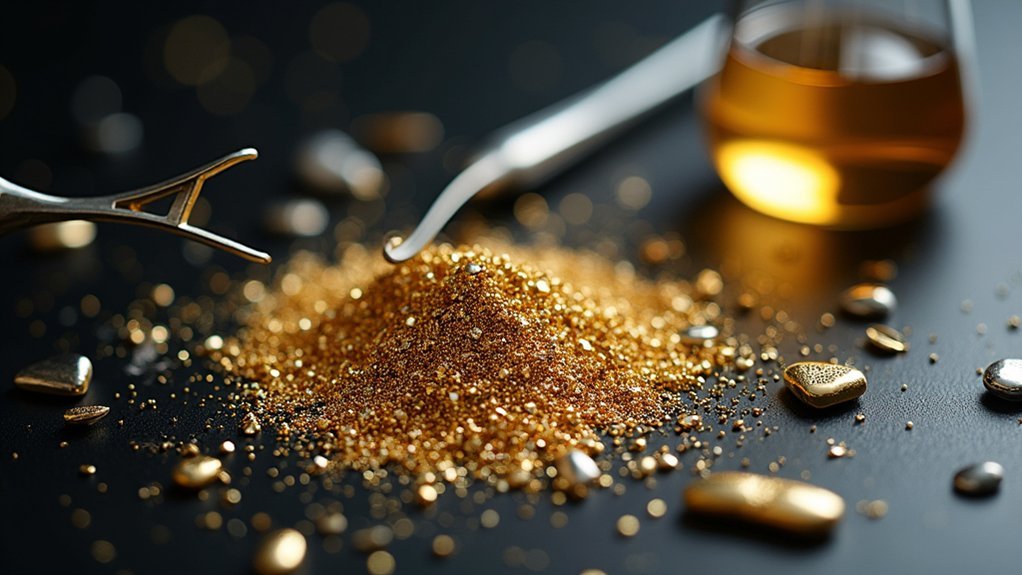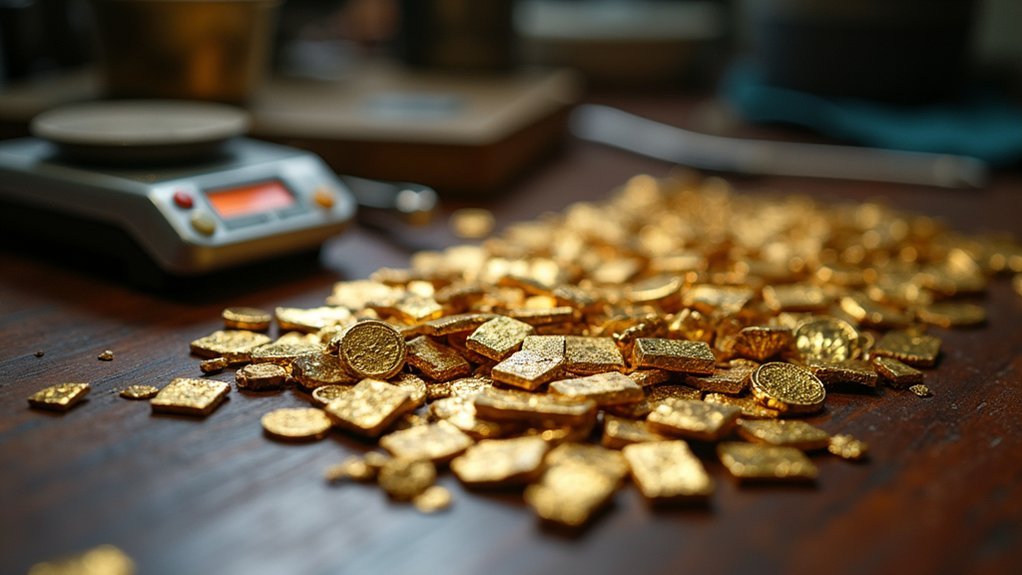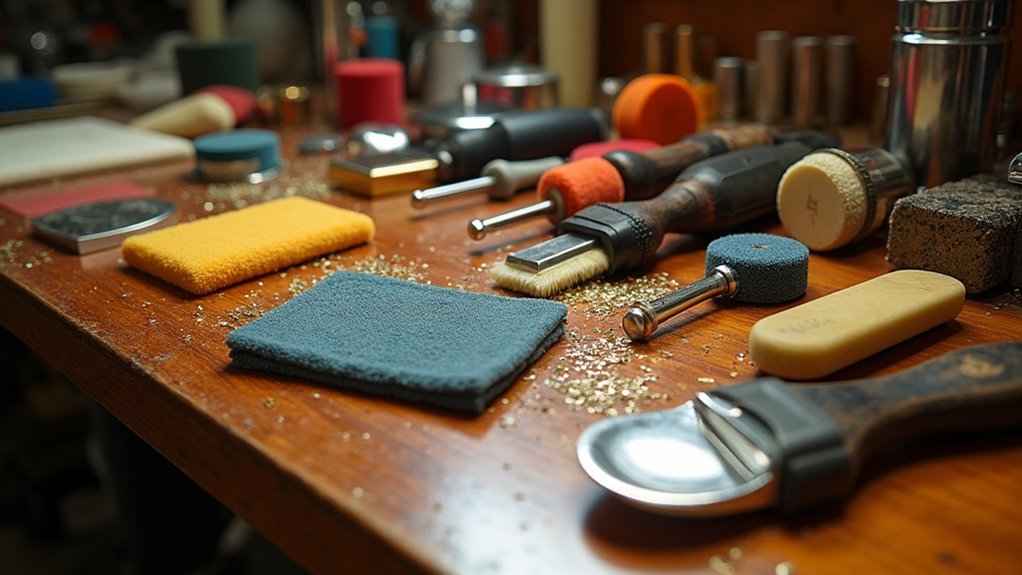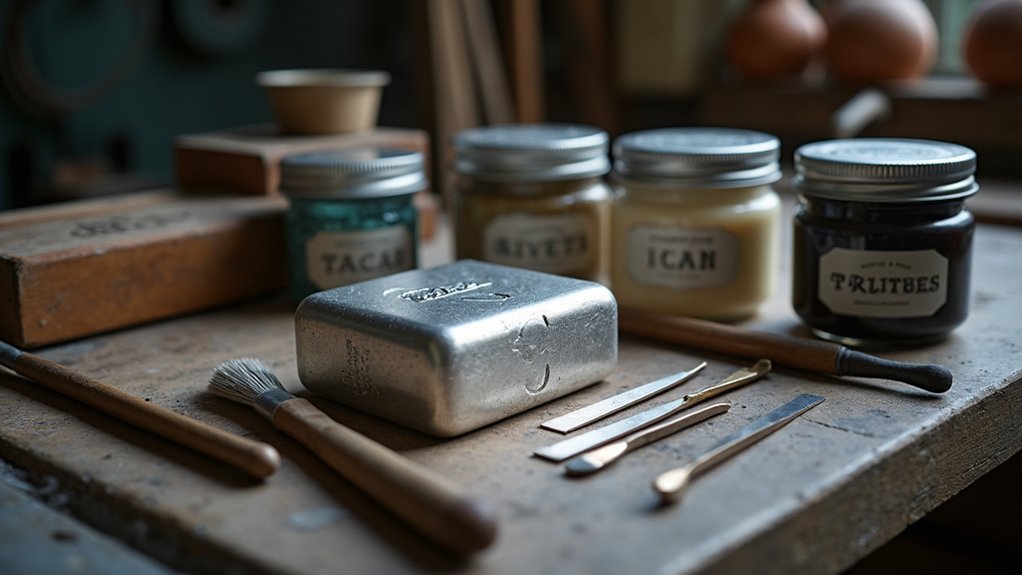Master precious metal refinishing by first analyzing your scrap material’s composition for accurate quotes, then selecting 2-3 licensed refiners to compare services. Implement robust dust collection systems with dedicated vacuums to prevent value loss, while maintaining proper ventilation and wearing chemical-resistant PPE. Schedule collections when accumulation guarantees profitability, eliminate extraneous materials to reduce costs, and conduct thorough quality control inspections using spectrometry techniques. These essential strategies will elevate your refinishing operations considerably.
Understanding the Fundamentals of Precious Metal Separation Processes

When you’re beginning precious metal refinishing, you’ll need to master two fundamental separation processes: pyrolysis and hydrolysis.
Pyrolysis uses high-temperature melting to solidify noble metals like gold and silver into cinder, separating them from non-noble materials. Hydrolysis employs chemical reactions with aqua regia or hydrochloric acid and chlorine gas to dissolve these precious metals for extraction.
Before starting either process, you must thoroughly analyze your scrap material’s physical composition. This understanding directly impacts your potential returns and overall profitability.
Don’t underestimate sampling analysis—it’s essential for accurate quotes and ideal value recovery.
Since these procedures involve complex techniques and regulatory requirements, seeking professional help guarantees you maximize your metal separation efforts while maintaining compliance and safety standards throughout the refinishing process.
Selecting the Right Refiner and Building Productive Partnerships
Once you’ve mastered the separation fundamentals, selecting the right refiner becomes your next critical decision.
You’ll want to compare quotes and services from at least 2-3 businesses to understand each option’s cost-benefit ratio.
Don’t forget to verify your refiner’s regulatory compliance by checking their Environment Agency licenses—this protects you from potential liability issues.
Building a productive partnership requires maintaining open communication about your collection needs and specific requirements.
This streamlines processes and improves efficiency.
Trust the quotes you receive and avoid delaying refining based on market speculation to maximize your returns.
When you analyze unexpected returns from refining, you’ll gain valuable insights into your refiner’s process efficiency, helping you make informed decisions for future partnerships.
Proper Material Preparation and Collection Optimization

After establishing a solid refiner partnership, you’ll need to focus on preparing your materials properly to maximize both efficiency and returns. Proper material preparation begins with eliminating extraneous items from your scrap, which notably reduces refining time and costs.
Follow best-practice guidelines provided by your refiner during preparation to achieve better quality and higher returns from refined metals.
Schedule collections only when you’ve accumulated enough scrap to guarantee economic viability and minimize transport expenses. Communicate your specific collection needs with your refiner for tailored service, assuring only valuable materials are picked up.
Regularly assess your collection process for efficiency, confirming that only precious metals are included to maximize potential yield during refining.
Implementing Effective Dust Collection and Workspace Management
Since precious metal particles can easily escape your workspace and represent significant value loss, implementing a robust dust collection system becomes essential for maximizing your refining returns. You’ll want to install a dedicated vacuum with a fish-mouth attachment to capture fine metal particles efficiently. Adapt woodshop ventilation systems to collect dust directly from floors, preventing particles from being tracked outside.
| Equipment | Purpose | Maintenance Frequency |
|---|---|---|
| Fish-mouth vacuum | Fine particle collection | Weekly filter checks |
| Dust Deputy pre-filter | Enhanced vacuum performance | Monthly cleaning |
| Floor ventilation | Direct dust collection | Bi-weekly inspection |
| Dedicated uniforms | Particle containment | Send to refiners quarterly |
| Filter systems | Air purification | Replace monthly |
Regular maintenance of your dust collection equipment, including filter replacements and hose cleaning, prevents blockages and maintains peak performance for precious metal recovery.
Mastering Buffing Techniques for Professional Surface Finishes

While effective dust collection preserves valuable metal particles, achieving mirror-like finishes requires mastering the art of progressive buffing techniques.
Start with cut buffing using a stitched sisal buffing wheel paired with coarse compound to eliminate deep scratches and surface imperfections. You’ll need to maintain consistent angles and apply light pressure throughout the process to prevent overheating while ensuring uniform results.
Cut buffing with stitched sisal wheels and coarse compound removes deep scratches while maintaining consistent angles and light pressure.
Use overlapping strokes to cover all areas thoroughly, stopping periodically to inspect your progress. Don’t cross-contaminate compounds—designate separate wheels for each buffing stage. This systematic approach guides you smoothly from coarse to fine polishing processes.
Always wear protective gear and work in well-ventilated spaces to avoid inhaling dust and fumes during operation.
Essential Safety Protocols and Regulatory Compliance
Before you begin any precious metal refinishing project, you’ll need to secure proper Environmental Agency licensing to operate legally and avoid costly penalties.
Install adequate workplace ventilation systems to protect yourself and your team from harmful chemical fumes that can cause serious health issues.
Always wear appropriate personal protective equipment, including chemical-resistant gloves, safety goggles, and respiratory protection when handling acids and other refining chemicals.
Environmental Agency Licensing
Although precious metal refining can be highly profitable, you must obtain proper Environmental Agency licensing before starting operations.
These licenses guarantee you’re complying with environmental regulations and safety protocols that protect both your workers and surrounding communities.
You’ll need to demonstrate strict adherence to waste management practices and pollution control measures during the application process.
The Agency wants proof you can minimize environmental impact throughout your refining operations.
Once licensed, expect regular audits and inspections to verify ongoing compliance with industry standards.
Don’t risk operating without proper licensing – you’ll face legal penalties, hefty fines, and potential shutdown.
Stay current with regulatory changes, as the Agency periodically updates licensing requirements based on evolving environmental standards.
Workplace Ventilation Systems
When you’re refining precious metals, implementing robust workplace ventilation systems becomes your first line of defense against dangerous airborne contaminants.
You’ll need to install local exhaust ventilation (LEV) systems that capture harmful particles directly at their source during metal refining processes. OSHA compliance isn’t optional—you must maintain adequate ventilation to meet regulatory air quality standards and protect workers from hazardous exposure levels.
Regular maintenance is critical for effective operation. Replace filters according to manufacturer recommendations and conduct routine inspections to guarantee peak performance.
Don’t overlook employee training—educating your team about ventilation importance and safe practices creates a safety-focused culture. This all-encompassing approach reduces health risks from dust and fume inhalation while maintaining the controlled environment essential for successful precious metal refinishing operations.
Personal Protective Equipment
While ventilation systems protect your workspace from airborne hazards, personal protective equipment serves as your final barrier against direct chemical exposure and physical harm.
When refining precious metals, you’re handling corrosive acids, toxic fumes, and metal particles that can cause serious health issues without proper protection.
Your PPE must meet industry standards and undergo regular inspection. Replace any damaged equipment immediately—compromised gear won’t protect you when you need it most.
Here’s your essential PPE checklist:
- Chemical-resistant gloves – Protect hands from acids and caustic solutions
- Safety goggles with side shields – Guard eyes from splashes and metal particles
- Respiratory protection – Filter harmful vapors and dust particles
Always review Material Safety Data Sheets for each chemical you’ll use, understanding proper precautions and emergency procedures.
Post-Refinishing Care and Quality Control Methods
The success of your precious metal refinishing project hinges on what happens after the primary refining process concludes.
You’ll need to conduct thorough quality control inspections using spectrometry techniques to verify purity and composition meet industry standards. Maintain a sterile environment throughout to prevent contamination that could compromise your finished product.
Carefully examine every surface for imperfections, scratches, or residual contaminants. Document each step and result to create traceable records for future reference and continuous improvement.
Apply post-refining treatments like polishing compound to enhance aesthetic appeal and durability. Consider protective coatings when appropriate for specific applications.
Regular quality checks throughout the entire process guarantee consistent results and help identify potential issues before they affect your final product’s integrity and marketability.
Frequently Asked Questions
What Precious Metal Will Increase in Value?
You’ll likely see palladium and rhodium increase most due to automotive industry demand for catalytic converters. Gold remains stable during downturns, while silver benefits from electronics growth. Consider diversifying across multiple metals.
How to Purify Precious Metals?
You’ll dissolve gold and silver using aqua regia, a hydrochloric and nitric acid mixture. Alternatively, you can melt metals through pyrolysis to separate impurities. Accurate sampling guarantees you’re choosing the most effective purification method.
What Is the Best Way to Own Precious Metals?
You should buy physical bullion from reputable dealers with proper certification. Diversify across gold, silver, platinum, and palladium. Store securely with insurance protection and monitor market trends for strategic buying decisions.
How to Polish Precious Metals?
You’ll want to clean your metals first, then use specialized polishing cloths with cleaning compounds. For deeper polishing, try a rotary tool with buffing wheel, testing inconspicuous areas first.
In Summary
You’ve now got the essential knowledge to tackle precious metal refinishing like a pro. Don’t rush the process—take time with material prep, maintain your workspace properly, and never compromise on safety protocols. Remember that quality refinishing isn’t just about technique; it’s about building the right partnerships and following through with thorough quality control. Apply these seven tips consistently, and you’ll see dramatic improvements in your results and efficiency.





Leave a Reply